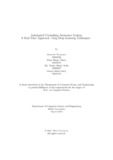| dc.contributor.advisor | Rhaman, Md. Khalilur | |
| dc.contributor.advisor | Reza, Md Tanzim | |
| dc.contributor.author | Moonjarin, Musarrat | |
| dc.contributor.author | Charu, Krity Haque | |
| dc.contributor.author | Nafis, Kh. Fardin Zubair | |
| dc.contributor.author | Sawly, Suraya Jahan | |
| dc.date.accessioned | 2023-09-24T05:29:51Z | |
| dc.date.available | 2023-09-24T05:29:51Z | |
| dc.date.copyright | 2023 | |
| dc.date.issued | 2023-03 | |
| dc.identifier.other | ID 19101586 | |
| dc.identifier.other | ID 19101173 | |
| dc.identifier.other | ID 19301007 | |
| dc.identifier.other | ID 19101383 | |
| dc.identifier.uri | http://hdl.handle.net/10361/21170 | |
| dc.description | This thesis is submitted in partial fulfillment of the requirements for the degree of Bachelor of Science in Computer Science and Engineering, 2023. | en_US |
| dc.description | Cataloged from PDF version of thesis. | |
| dc.description | Includes bibliographical references (pages 43-46). | |
| dc.description.abstract | Road accidents are one of the major causes of fateful deaths in Bangladesh. In most
cases it is caused by Overtaking on highways or on regular roads. In terms of overtaking
the major task is to decide whether the overtaking is safe or not. There has
been a lot of work considering autonomous communication in this field. However,
the challenges in terms of Bangladesh, need different and user-friendly solutions.
Considering the interest of researchers in this area and to introduce a different evolutionary
trend in Bangladesh we approached this research. In this research our basic
concept is to suggest the safe overtaking decision to the host drivers considering an
overall idea of the environment. Our work aims to decrease early and unfortunate
deaths caused by vehicle’s abrupt overtaking on Bangladesh’s Highways by assisting
drivers based on deep learning techniques. Furthermore, the Autonomous system
considers communication between vehicles to decide safe overtaking within minimum
time.V Vehicle detection and classificationdetection and classification is done
using the YOLO model. After measuring the distance and relative velocity, our
model suggests the decision by using the help of other significant models used in our
research. For distance measurement, we used SegNet and a distance measurement
model. In addition, for getting relative velocity we have used optical flow and also
for checking whether the driver is on the right lane or not, we have used the PiNet
model for lane detection. Moreover, we have no use of other sensors besides the
camera and kept only one camera in our proposed system. So in future, users will
get this autonomous system in their vehicles at low cost as our system proposes.
Experimental results from the proposed system show that deep learning process is
better in terms of our country. | en_US |
| dc.description.statementofresponsibility | Musarrat Moonjarin | |
| dc.description.statementofresponsibility | Krity Haque Charu | |
| dc.description.statementofresponsibility | Kh. Fardin Zubair Nafis | |
| dc.description.statementofresponsibility | Suraya Jahan Sawly | |
| dc.format.extent | 46 pages | |
| dc.language.iso | en | en_US |
| dc.publisher | Brac University | en_US |
| dc.rights | Brac University theses are protected by copyright. They may be viewed from this source for any purpose, but reproduction or distribution in any format is prohibited without written permission. | |
| dc.subject | Image processing | en_US |
| dc.subject | Overtaking | en_US |
| dc.subject | Autonomous | en_US |
| dc.subject | Distance measure | en_US |
| dc.subject | SegNet model | en_US |
| dc.subject | PINet | en_US |
| dc.subject | Optical flow | en_US |
| dc.subject | YOLO | en_US |
| dc.subject | Deep learning | en_US |
| dc.subject.lcsh | Cognitive learning theory | |
| dc.subject.lcsh | Machine learning | |
| dc.title | Automated overtaking assistance system: a real-time approach using deep learning techniques | en_US |
| dc.type | Thesis | en_US |
| dc.contributor.department | Department of Computer Science and Engineering, Brac University | |
| dc.description.degree | B. Computer Science and Engineering | |

